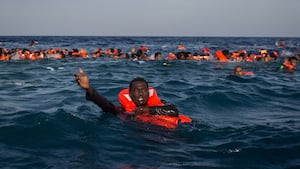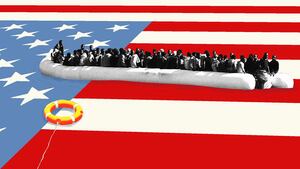ROME—No one may ever know for sure if the baby boy was dead before or after he was pushed out to sea on a tiny migrant boat with around 100 other people. It is unclear if he was with a parent or had been handed to a stranger when the distress call to the non-governmental organization Alarm Phone was made Sunday morning. “We are freezing,” the caller said, explaining that most of the people on the boat were weak from months of abuse in Libyan detention. “A baby has passed out. Maybe he's already dead.”
For hours the boat bobbed and swirled in the chilly winter waters of the Mediterranean while the Alarm Phone operators played phone tag with Italian and Maltese authorities who wasted precious time, each arguing why the listing vessel was not in their Search and Rescue jurisdiction. The eight phone numbers the NGO had for the Libyan Coast Guard, whose jurisdiction the sinking boat was in, apparently were all out of service. By nightfall, the battery on the cellphone on the little boat had died so there was no more contact.
Those pushed out to sea in recent weeks are part of a shifting trend in Mediterranean migration. It used to be that migrants paid vast sums of money to smugglers to move them across the Mediterranean, or at least as far as NGO rescue boats which would take them the rest of the way to Italy.
Now the real money is made inside the detention centers where militia groups tied to the smuggling families run extortion rackets. They only send them to sea when they can’t get any more out of them and want to make room for new victims.
When new migrants and refugees arrive in the detention centers, they say they are often tortured or raped with the promise that it will stop if their families back home just send more money.
The Daily Beast interviewed several people who had arrived from Libya who shared the same story of exploitation. All of them were tortured with electric shock—the men often to the testicles—to ensure that there was no more money to be sent. When it was clear that there wasn’t, they were sold as slaves or released to smugglers to make room for others.
Since Italy's populist government guided by right-wing interior minister and vice premier Matteo Salvini closed Italy's ports last June, migrant arrivals into Italy are down by more than 80 percent. And as the boat departures decrease, the conditions for those stuck in Libya get worse.
Several people who have been rescued by the one remaining NGO boat or by Italian or Maltese coast guards in the last month say Libyan forces essentially handed them to smugglers to make room in the detention centers for fresh victims they can exploit for money.
Once they are pushed out into the water as human skeletons, their chances of survival are low. Last Friday, two Sudanese and one Ghanaian man were miraculously plucked from the sea by an Italian Navy helicopter after the sinking of their boat with more than 120 people on it. Another boat with over 50 dropped off the radar after its distress calls turned silent. The survivors were suffering from severe hypothermia, in part because they were so malnourished from their time in Libya they had little body fat to sustain them, according to the doctor who treated them on the Italian island of Lampedusa.
A report called “No Escape From Hell: EU Policies Contribute to Abuse of Migrants in Libya” issued by Human Rights Watch on Monday paints a disturbing portrait of what Italy's closed ports mean to those stuck on the other side. Human Rights Watch visited several detention centers in Tripoli, Misrata and Zuwara last summer after Italy’s closed ports policy started creating a backlog of people intending to cross the sea. “There is significant evidence that smugglers operate in varying degrees of collusion with [Libyan] government officials and militias,” the report says.
In the official centers run by the Government of National Accord, HRW witnessed “inhumane conditions that included severe overcrowding, unsanitary conditions, poor quality food and water that has led to malnutrition, lack of adequate health care, and disturbing accounts of violence by guards, including beatings, whippings and the use of electric shocks.”
The organization says between 8,000 and 10,000 people are thought to be in Libya’s official detention centers, where their safest hope to escape is to pay off guards or consular officials, the report says. The United Nations estimates that a further 680,000 live outside these official centers, many in rogue informal detention warehouses where there are no officials to bribe.
Most of the official centers are actually run by militias who control the neighborhoods where the centers are located, according to Human Rights Watch. These militia groups also run the smuggling rings, which makes it convenient when it is time to clear space.
The Libyan Coast Guard used to be tied to the militia groups as well, which made it easy for smugglers to get out of Libyan waters. Now the Libyan Coast Guard has been bolstered by Italian vessels and training so they feel compelled to stop the smuggler vessels and bring them back to Libya, even if it means the people will essentially be recycled and sent out again.
When the Libyan Coast Guard can’t reach boats in distress, they call on merchant ships to do it for them and then take the migrants by force since most refuse to disembark ships onto Libyan vessels knowing what is waiting for them back on the North African coast.
In November 2018, the Libyan Coast Guard resorted to tear gas and rubber bullets to remove around 80 people from a merchant ship to return them to Misrata, where they were beaten again. U.N. agencies working on the ground said 11 of the returnees were seriously injured, including three people with gunshot wounds.They were then taken back to the detention centers.
“The policies in place are contributing to the cycle of abuse,” Judith Sunderland, associate director for Human Rights Watch’s European and Central Asia division, told The Daily Beast. “While they have clearly led to a reduction of numbers of arrivals, they have contributed to an increase of deaths at sea.”
Women are held in separate detention in Libya, but the guards are all male and there is widespread sexual violence, the human rights group says. “Survivors of sexual violence before or during detention have extremely limited options for physical and psychological care,” the report states, adding “sexual violence is a widespread phenomenon along the migration journey, in Libya, and in detention centers.”
While gathering information for its report, the humanitarian group witnessed a woman attempt suicide by hanging herself with a belt and two women in full seizure on a cold cement floor with no medical assistance. The human rights organization was not allowed anywhere near the unofficial centers which are thought to be far worse.
The solutions proposed for those stuck in limbo are not promising. UNHCR and the UN’s International Organization for Migration (IOM) do offer voluntary evacuation and repatriation from Libya, which often means returning to war zones or areas of devastating poverty.
The other option is being pushed out to sea where they are likely either to perish or get right back to Libyan hell.
“In the immediate term, there are very concrete things that EU and members states like Italy should do, which is first of all acknowledge that the strategy is not working,” Sunderland says. “Italy is only using one metric—arrivals. The metrics should involve whether these policies are leading to more rights being respected and more people finding the protection they need.”










